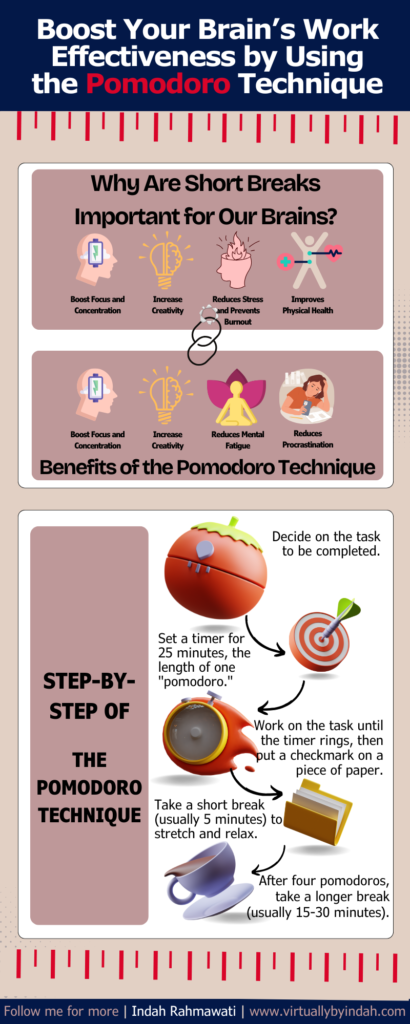-
- Boost Focus and Concentration: Working continuously without taking a break can decrease our concentration. By taking short breaks, we can restore our focus, allowing us to return to work with a fresher, sharper mind.
- Increases Creativity: The human brain needs time to process information and form new ideas. By resting, we give our brain the opportunity to reflect and come up with creative solutions to the problems we face.
- Reduces Stress and Prevents Burnout: Taking small breaks allows the human brain to release the pressure and stress that accumulates while working. This is critical to avoid mental weariness or burnout, resulting in a negative influence on productivity and health.
- Improves Physical Health: Sitting or standing for extended periods might result in muscle stress and other health issues. Taking breaks to move or stretch promotes blood circulation and reduces muscle tightness.
By integrating regular short breaks into your work routine, we can keep our brain performing optimally, increase productivity, and maintain mental and physical well-being.
To apply this practice well, we can use a technique that can effectively manage our energy and emotion by allocating our working time effectively and efficiently. We can call this the Pomodoro Technique.
In the late 1980s, Francesco Cirillo developed the Pomodoro Technique as a time management method. The name “Pomodoro” comes from the Italian word for “tomato,” inspired by the tomato-shaped kitchen timer that Cirillo used when first developing the technique. Its main goal is to increase focus and productivity by dividing work or study time into structured intervals.
Basic Principles of the Pomodoro Technique and the Steps to Implement This Technique
This technique’s core ideas are simple enough to grasp and apply. The principles are as follows:
-
- Work Interval (Pomodoro): Work or study for 25 minutes with full focus on one task without distraction.
- Short Break: After a Pomodoro session, take a 5-minute break to stretch your muscles, drink water, or do some other light activity.
- Repeat Cycle: Repeat steps 1 and 2 four times. After completing four Pomodoro sessions, take a longer break, about 15 to 30 minutes, to restore energy before moving on to the next cycle.
-

Pomodoro Technique to Maintain Human Brain at Work
To apply the principles practically, you can try this step-by-step:
-
- Select Tasks to Do: Determine the specific tasks or work you want to complete.
- Set a Timer for 25 Minutes: Use a physical timer or digital app to set the time.
- Completely Focus on the Task: For 25 minutes, avoid all forms of distractions such as cell phones, social media, or other interruptions.
- Short 5-Minute Break: Once the timer goes off, stop for a moment to rest.
- Repeat Cycle: After four sessions, take a longer break before continuing again.
Benefits of the Pomodoro Technique
By practicing this technique regularly, we can get some benefits that affect our work productivity and the quality of our work results, such as:
-
- Improves Focus and Concentration: Working in regular time intervals allows us to minimise distractions while remaining focused on the subject at hand.
- Reduces Mental Fatigue: Taking frequent brief pauses helps prevent fatigue and keeps the mind fresh.
- Reduces Procrastination: This strategy instills a sense of urgency and aids in the elimination of the desire to postpone work. For more detailed information about procrastination and its effects, you can read one of my previous articles about “Unlocking a New Side About Procrastination.”
- Increases Productivity: Breaking down work time into concentrated sessions enables more efficient task completion.
That is what the Pomodoro technique can be very effective for boosting the human brain’s cognitive part that leads to an incredible result of our work. Particularly, this technique can be very effective when we work on a specific project or client. Furthermore, when you maintain your time well to focus on one client and then switch to another client, your brain also needs to relax in some moments to avoid burnout.
In the section below, I provide a simple infographic to help you understand more about the Pomodoro technique and its impact on the human brain mechanism that can effectively improve our work and learning results. Try this and feel the difference before and after you use this technique.



